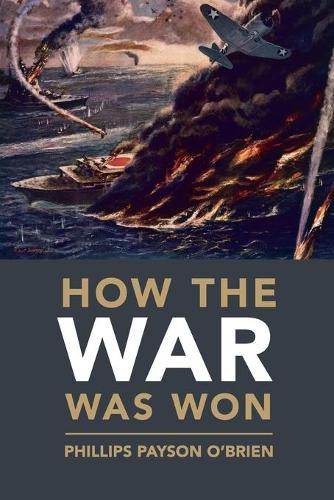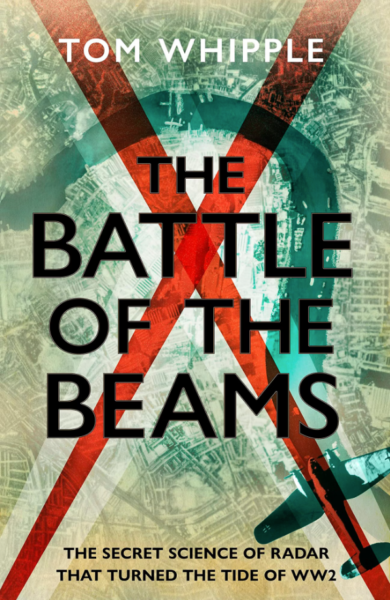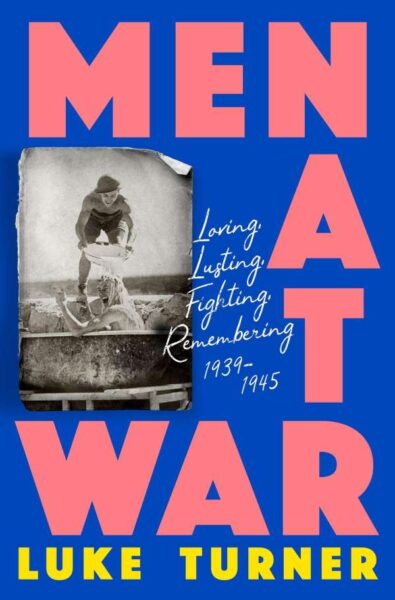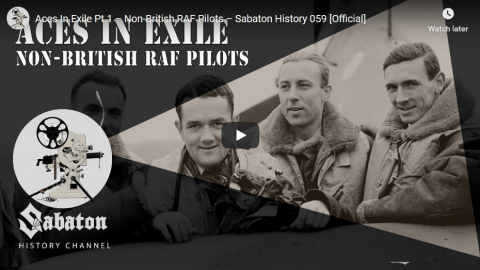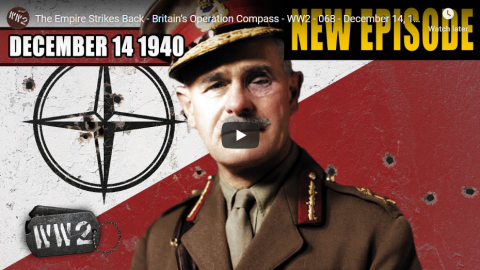World War Two
Published 1 Mar 2025Indy and Sparty answer questions about the Battle of Britain! Spitfire vs Bf 109, the Big Wing Debate, and whether Goering had any kind of plan for the battle.
(more…)
March 2, 2025
Which is better – Spitfire or Bf 109? – Battle of Britain Fireside Chat
January 2, 2025
Why Germany Lost the Battle of Britain
Real Time History
Published 2 Aug 2024Summer 1940. The United Kingdom is gripped by the fear of a German invasion. Even if the Luftwaffe secures the sky over Britain, could Germany’s Operation Sea Lion ever really work?
(more…)
September 8, 2024
Romney Marsh and the Battle of Britain (BBC 1976)
BBC Archive
Published Jun 2, 2024Romney Marsh has been dubbed the “sixth continent”, due to its size and the sense that it has its own rules.
A shingle beach that silently grows bigger every year, scattered debris from the Battle of Britain, an old-fashioned lighthouse hidden from the sea by a nuclear power station. It has a character unlike anywhere else in the UK.
Presented by Dilys Morgan and Bernard Clark.
Clip taken from Nationwide on the Road: Romney Marsh, originally broadcast on BBC One, Wednesday 7 April, 1976.
You have now entered the BBC Archive, a time machine that will transport you back to the golden age of TV to educate, entertain and enlighten you with classic clips from the BBC vaults.
August 15, 2024
July 8, 2024
Train & Public Transport in London (1941)
Charlie Dean Archives
Published Sep 24, 2013According to tfl.gov.uk: “Not only did the Tube help 200,000 inner-city children escape to the country, it was also used to shelter hundreds of thousands of civilians every night during the Blitz. On 27 September 1940 a census found that a staggering 177,500 Londoners were sleeping in Tube train stations. With so many people seeking shelter in the Tube, London Underground sprang into action and installed 22,000 bunk beds, washroom facilities and even ran trains that supplied seven tonnes of food and 2,400 gallons of tea and cocoa every night. Before long there were even special stations with libraries, evening classes, movies and musical evenings.”
The film states that 10 million people used public transport in London. Today, that figure stands at around 8.6 million. The opening title cards state that this film began filming just as the London Blitz began, yet there is very little visual reference to this.
(more…)
October 23, 2023
The RAF’s true workhorse fighter in the Battle of Britain – the Hawker Hurricane
William Loneskie sings the praises of the Hawker Hurricane, the main fighter plane of the Royal Air Force during the Battle of Britain in 1940:
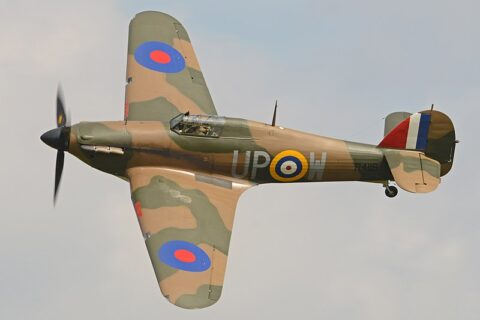
Hawker Hurricane Mark I. This is the only airworthy Hurricane with a genuine Battle of Britain history. Since 2015 she has lodged with the Shuttleworth Collection and is seen displaying at the 2017 Season Premier Airshow at Old Warden, Bedfordshire, UK.
Photo by Alan Wilson via Wikimedia Commons.
In the popular mind it was the Supermarine Spitfire which carried the day for the Royal Air Force during the Battle of Britain. The grace of RJ Mitchell’s design was appreciated by the public as something very special, as it was for the pilots who flew it.
But it was the slower Hawker Hurricane which accounted for most of the German airmen killed in 1940 and destroyed most of their Heinkels, Junkers and Dorniers. Although nearly 200 Hurricanes had been lost in the Battle of France there were 32 squadrons of Hurricanes in the Battle of Britain compared with 19 of Spitfires.
By the time air battles commenced over England in 1940, the RAF had a secret weapon – BAM 100. This was British Air Ministry 100 octane fuel which had been developed and manufactured in the United States, bought for cash by the UK government, and shipped across the Atlantic by tankers. Compared with the previous 87 octane petrol, the new fuel boosted the speed of the Hurricane and the Spitfire by around 30mph. The Luftwaffe pilots were taken by surprise and couldn’t understand where the extra power came from until later in the war German technicians tested fuel from a downed aircraft.
Side by side the Spitfire and Hurricane, both powered by the iconic Rolls-Royce V12 Merlin, were very different. The Spitfire with its elliptical wing and perfect proportions “looked as if it could fly”, as Sergeant Cyril Bamberger of 610 and 41 squadrons said. But the Hurricane, if not quite an ugly duckling, had an ungainly appearance.
While the Spitfire was of all-metal construction, the Hurricane’s structure was a halfway house between fabric covered biplanes, such as the Gloster Gladiator, and all-aluminium monoplanes. An unintended consequence of the Hurricane’s fabric-covered fuselage was that German cannon shells could pass straight through without exploding. Its pilots soon realised that the Hurricane could take a lot of punishment, and the ground crews, the unsung heroes of the battle, could often repair the aircraft on station unlike the Spitfire, which was difficult to produce, maintain and repair.
Getting airborne in a squadron scramble, or landing on a grass airstrip, the Hurricane was safer than its compatriot because Camm had designed its undercarriage to open outwards, not inwards, making its track wider.
In the air the Hurricane shrugged off its ugly duckling appearance and became a killing machine. Flight Lieutenant Peter Brothers of 32 and 257 Squadrons said: “It was a superb combat aircraft … it was a better gun platform than the Spitfire”. Squadron Leader Tom Dalton Morgan said that, although he had flown more hours on the Spitfire, “as a fighting machine I preferred the Hurricane”.
The Hurricane could out-turn a Messerschmitt Bf109. Its turning radius of 785ft compared with 895ft for the German machine and 860ft for the Spitfire. The Hurricane’s thick wing allowed a different configuration of its eight .303 Browning guns giving a closer concentration of fire at a rate of 19 rounds per second.
July 23, 2023
Tom Whipple’s history of radar development during WW2
In The Critic, Robert Hutton reviews The Battle of the Beams by historian Tom Whipple, who retells the story of the technological struggle between Britain and Germany during the Second World War to find ways to guide RAF or Luftwaffe pilots to their targets:
In an age when my phone can tell me exactly where I am and how to get where I’m going, it’s hard sometimes to imagine a time when navigation was one of any traveller’s great challenges. At the outbreak of the Second World War, the advice to Royal Air Force pilots trying to find their way was, more or less, to look out of the window and see whether anything on the ground looked familiar. The Luftwaffe, though, had a rather more sophisticated means of finding their targets.
As Britain braced herself for the bomber onslaught of 1940, there was comfort in knowing that radar would give Hurricanes and Spitfires advance warning of where the attack was coming. As soon as the sun went down, so did the fighters: at night, relying on their eyeballs, they simply couldn’t find the enemy.
That wasn’t so bad, as long as the German pilots had the same problem, but one young British scientist began to suspect that the Luftwaffe had developed a technology that allowed them to find their way even in the dark, guided by radio beams. In June 1940 he found himself explaining to Winston Churchill that German bombers could accurately reach any spot over England that they wanted, even in darkness.
Reg “RV” Jones was the original boffin: a gifted physicist who was recruited to the Air Ministry at the start of the war to help make sense of intelligence reports that offered clues about enemy technology. It was a role to which he was perfectly suited: a man who liked puzzles, with the ability to absorb lots of information and see links, as well as the arrogance to insist on his conclusions, even when his superiors didn’t like them.
The story of the radio battle has been told before, not least by Jones himself. His 1978 memoir Most Secret War was a bestseller and remains in print. It is 700 pages long, though, and it assumes a lot of knowledge about the way 1940s radios worked that readers probably had 50 years ago. Since few people under 50 have much clue why a radio would need a valve or what you might do with a slide rule, there is definitely room for a fresh telling.
April 24, 2023
Even fighter pilots and gunners have love lives
In The Critic, John Sturgis reviews a new book by Luke Turner titled Men at War: Loving, Lusting, Fighting, Remembering 1939-1945, which considers the myths and reality of wartime relationships during the Second World War:
Spitfire pilot Ian Gleed shot down five enemy aircraft in just a week in May 1940 — the fastest time in which this had ever been done, making him an official “ace” who would be quickly promoted to Wing Commander.
Gleed had become a poster boy for “the few”, the hero pilots of the Battle of Britain to whom so many would owe so much. He lived up to the popular image with his talk of “a bloody good show” and shooting down “damned Huns”, after which he’d sink a few warm beers and spend some “wizard” free time recuperating with his girlfriend Pam, whom he “loved now more than ever”.
Gleed’s luck finally ran out over Tunisia in April 1943 when his plane was hit by a German fighter and crashed into dunes. Gleed was killed. He was just 26.
It would only emerge decades later that much of the popular image he had cultivated simply wasn’t true. Gleed was gay. Pam was an imaginary character he had invented as a cover to keep his double life as a sexually active homosexual firmly secret.
Gleed’s story is one of many similar vignettes in this alternative history of the Second World War. Its author Luke Turner’s previous book was a memoir about his own grappling with issues around his identity as a bisexual. Here he takes up the question of how this would have played out for him and other sexual non-conformists in 1939–45.
Turner grew up obsessed with the war — everything from Airfix kits and Dad’s Army to Stalingrad and the Berlin bunker — and here he examines what it was to live through that period as a sexually active person of whatever hue. It proves a particularly rich subject matter as sex seems to have been everywhere in war time: everyone was sleeping with everyone else, apparently. It’s a perennial truth that you or I might be hit by a bus tomorrow — but make that bus a bomb, and suddenly this seems to create a sense of urgency which frequently manifests itself sexually, lending daily life what Turner calls “an aphrodisiac quality”. As Quentin Crisp put it when describing the shenanigans in blacked-out, Blitz London: “As soon as the bombs started to fall, the city became like a paved double bed.”
Whilst war may see an explosion of sex of all kinds, the establishment was not always comfortable with this. A Home Office report on public behaviour in London during the Blitz noted, “In several districts cases of blatant immorality in shelters are reported; this upsets other occupants of the shelters.”
One contemporary account suggests, “In wartime a uniform, whether of the Army, Navy or Air Force, to the average girl ranks as a fetish.” This had consequences in the field: Dear John letters from home could be a real problem in this regard. As an Army report in 1942 put it, morale is often damaged by “the suspicion, very frequently justified, of fickleness on behalf of wives and girls”.
Amongst all this sex was, of course, sex with Americans. Turner cites George Formby who captured this mood in the song “Our Fanny’s Gone All Yankee”: “She don’t wait for the dark when she wants to have a lark/In a bus or train she does her hanky panky.”
Then in a dark reversal of this two-nations-colliding-sexually motif, we get the horror of the Red Army’s organised rape of as many as 1.4 milllion German women during the Russian advance on Berlin, whose residents would later refer to the city’s grandiose monument to Soviet war dead as “the tomb of the unknown rapist”.
June 26, 2022
QotD: Breaking the trench stalemate with strategic air power
The first efforts at strategic bombing were made in WWI, though once again the technology wasn’t ready. The range for fixed-wing aircraft was still very limited; the aforementioned Farman F.50 had a range of only 420km, nowhere near enough to really bring entire countries under the threat of bombing. Dirigibles – zeppelins – could manage much longer ranges and the Germans did attempt to bomb British cities with them starting in 1915. The problem was that once aircraft powerful enough to climb to the zeppelin’s altitude were developed, the slow and fragile zeppelins were sitting ducks: lighter than air airships could hardly be armored, after all. Moreover, the bomb loads of zeppelins had always been far too low to make effective strategic bombing possible beyond the initial shock of it.
What no one could have known in WWI was not merely that the technology for effective conventional strategic bombing wasn’t ready, but that it would probably never be ready. Interwar air-power theorists, seeing the potential of strategic airpower to bypass the trench stalemate by flying over it began to try to work out how this would be done. Giulio Douhet (1869-1930) argued that future wars would be fought and won in the air, with fleets of bombers using high explosives and chemical weapons to massacre enemy civilian centers, until civilians forced their governments to surrender. Douhet was not alone; his vision of airpower as shared, for instance, by the “father of the RAF”, Hugh Trenchard (1873-1956).
This concept, “morale bombing” as it is sometimes called, probably deserves its own post discussing its failures. But in brief, the concept was tested, with far larger amounts of bombs than Douhet or any other interwar theorist could have ever dreamed of, during WWII. The argument by air theorists that high altitude bombers could not be stopped was proved false when the British did exactly this, stopping German bombers over Britain in 1940. Moreover, terror bombing against civilian targets in Britain didn’t lead to surrender, but hardened resolve. Likewise, “morale” bombing against German targets by the allies didn’t lead to surrender, but hardened resolve. Later efforts to demoralize the North Vietnamese through a American bombing campaign in the Vietnam War didn’t lead to surrender, but hardened resolve. More recent efforts to demoralize or destroy terrorists and the Taliban through the use of airpower hasn’t lead to surrender, but rather hardened resolve. Likewise, efforts by the Syrian regime to defeat various opposition groups in Syria through the use of chemical weapon-based terror bombing didn’t lead to surrender (siege-and-starve tactics did), but hardened resolve.
It turns out the fundamental premise of the entire idea of morale bombing – that being bombed will make people want to stop fighting – was flawed. Morale bombing has been, depending on how hard you squint at the US air campaign over Japan in WWII (including the use of nuclear weapons) successful either once (out of many attempts) or never. In most cases, the sustained bombing of civilian centers has been shown to increase a population’s willingness to resist, making the strategy worse than useless.
The case for strategic bombing against industrial targets is marginally better, but only marginally. While airpower advocates, particularly in the United States promised throughout WWII that bombing campaigns against German industry could lead to the collapse of the German war machine, in the end many historians posit that the real achievement of the campaign was to lure the Luftwaffe into the air where it could be destroyed, thus denying the German army of air cover and close air support, particularly on the Eastern Front. Some dimunition of German industrial capabilities was accomplished (though it is not clear that this ever approached the vast resources poured into producing the large numbers of extremely expensive bombers used to do it, though the allies had such an industrial advantage over Germany, forcing the Germans to fight in expensive ways in the sky was a winning trade anyway), but the collapse of German industry never happened. As Richard Overy notes, German industrial output continued to rise during strategic bombing and only began to fall as a result of the loss of territory on the ground. Needless to say, “strategic bombing can sucker the enemy into wasting their close air support” was not the result that airpower advocates had promised, nor could it have broken the stalemate.
I don’t want to oversimplify the continued debate over the efficacy of strategic airpower here too much so let’s just say that the jury is still very much out as to if strategic airpower works even with modern technology; it certainly wouldn’t have worked with WWI era technology.
Bret Devereaux, “Collections: No Man’s Land, Part II: Breaking the Stalemate”, A Collection of Unmitigated Pedantry, 2021-09-24.
October 30, 2021
Revisiting the Battle of Britain
In The Critic, Phillips O’Brien has a historical hot take on the popular view of the Battle of Britain:
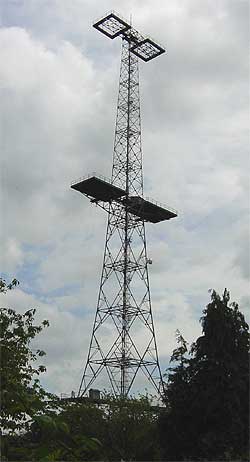
The Chain Home Tower in Great Baddow Chelmsford, a key part of Britain’s air defence network.
Photo by Stuart166axe via Wikimedia Commons.
The Battle of Britain was a lopsided affair. One side was much stronger and more modern, with advanced integrated detection technologies, superior logistics and intelligence, excellent fighter control, and much better production facilities churning out far more of the most important equipment.
The other side was plucky, flying from considerably less developed facilities, operating under severe handicaps in intelligence and flying time over the battle area, lacking the proper technology to achieve anything like what it wanted, and with a severely underutilized industrial base.
The stronger side was Great Britain and the plucky underdogs were the Germans.
The Battle of Britain was always one that the Germans were bound to lose quickly and disastrously. The key phase only lasted a few weeks during which German losses became unsustainably high and the Luftwaffe had to resort to the completely ineffective, if dramatic seeming, night time bombing of London and other British cities.
When the Battle of Britain entered this Blitz stage in early September, it was an admission by the Germans that they could not fly in the day over the UK and survive, and therefore they had no chance of actually damaging anything meaningfully in the UK.
Unfortunately this realistic vision of the Battle of Britain makes for both bad movies and bad politics, and for that reason a different vision has come down to us — that of plucky little Britain, relying on “the few” to defend itself against the mass power of the Luftwaffe and Nazi Germany.
This myth — partly witting, partly not — started to be created even before the Battle of Britain actually reached its climax, and it became such a useful one that it has persisted to today. Winston Churchill’s famous speech that “never has so much been owed by so many to so few” was given on August 20, 1940, though the Battle of Britain did not reach its highpoint until the two weeks between August 24 and September 6.
In that sense Churchill’s stirring phrase was a prophecy not a proper analysis — and it was a prophecy based on a fundamental misunderstanding of how strong the Luftwaffe and Germany were at the time. Churchill thought the Luftwaffe was twice as strong as it really was and that Germany was producing twice as many aircraft as it actually was. He believed that Britain had to rely on the few. It just wasn’t true.
Britain won the Battle of Britain because it was more powerful than Nazi Germany in the key areas the battle tested and because Britain was not standing alone, but fighting with a world-wide network of assets that meant it was never going to lose.
The Germans had one advantage going into the battle — the number of aircraft on hand (though the numbers of deployable German fighters was only a little higher than that of the RAF). However even this numerical advantage was partly irrelevant as German bombers, small, slow two-engine machines such as the HE-111 and DO-17, were inadequate to the task and the famous Stuka dive-bombers, even slower and more primitive, were more dangerous for their crews to fly than they ever were to the British being bombed by them.
In response the RAF had radar, which could see the Germans coming and give the RAF time to prepare, could fly for far longer over the Battle areas from its bases in southern England than the Germans could fly from their bases in France, and could rescue the majority of its pilots show down while the Germans lost theirs that survived to British prisoner of war camps.
August 30, 2021
QotD: “Veneer theory” of human nature
Before the Blitz the consensus was that a little light bombing was all it took to make the wheels come off civilisation. This is based on veneer theory — our good behaviour is a thin veneer laid on our fundamentally selfish, violent nature, and that under pressure our true nature will out.
This turned out not to be true. So spectacularly untrue that we still talk about the Blitz Spirit. With our trademark humility, the British concluded that this was due to our exceptional moral fibre and, with help from the Americans, set about bombing German civilians to hell and back. Regrettably the Germans too responded by pulling together, and working harder in the war effort. Literally no one thinks this was due to their exceptional moral fibre. Instead, it seemed that crisis led to teamwork. Bregman is able to quote similar behaviour on the Titanic, on September 11th and in the aftermath of Hurricane Katrina.
Despite this mountain of evidence, veneer theory is still overwhelmingly believed. In 1951 William Golding wrote Lord of the Flies — a book about how a group of British boys crash-landed on a Pacific island would really behave. They start with ideals of co-operation, but quickly descend to violence and anarchy. Weeks later when they’re rescued half of them are dead. The book became a massive best seller, and a much-studied classic. For those who lived through World War I, World War II, and were now watching communism demonstrate that you didn’t even need an enemy to slaughter tens of millions, you can see the appeal of a cynical view of human nature. However it is pure fiction. In 1966 Lord of the Flies happened for real — 6 teenagers went for a joy ride in a fishing boat, got swept out by a storm and washed up on an inhospitable island in the Pacific. When they were found 11 months later, they were all alive and healthy. They had survived by fortitude, resourcefulness and above all, teamwork.
An anonymous reviewer, “Your Book Review: Humankind”, Astral Codex Ten, 2021-05-28.
February 6, 2021
From an improbable 1930s “death ray” to the radar network that helped defeat the Blitz
In a story from a few years back, Tim Harford outlines how a British Air Ministry prize for developing a “death ray” to use against enemy aircraft eventually helped kick off the discovery of radar:
… sometimes inventions need other inventions to unlock their full potential.
For the aviation industry, that story starts with the invention of the death ray, or at least an attempt to design a death ray, back in 1935.
Officials in the British Air Ministry were worried about falling behind Nazi Germany in the technological arms race.
The death ray idea intrigued them: they had been offering a £1,000 prize for anyone who could zap a sheep at a hundred paces. So far, nobody had claimed it.
But should they fund more active research? Was a death ray even possible?
Unofficially, they sounded out Robert Watson Watt, of the Radio Research Station.
And he posed an abstract maths question to his colleague Skip Wilkins.
“Suppose, just suppose,” said Watson Watt to Wilkins, “that you had eight pints of water, 1km [3,000ft] above the ground.
“And suppose that water was at 98F [37C], and you wanted to heat it to 105F.
“How much radio frequency power would you require, from a distance of 5km?”
Skip Wilkins was no fool.
He knew that eight pints was the amount of blood in an adult human, 98F was normal body temperature and 105F was warm enough to kill you, or at least make you pass out, which — if you’re behind the controls of an aeroplane — amounts to much the same thing.
So Wilkins and Watson Watt understood each other, and they quickly agreed the death ray was hopeless: it would take too much power.
But they also saw an opportunity.
Clearly, the ministry had some cash to spend on research. Perhaps Watson Watt and Wilkins could propose some alternative way for them to spend it?
Wilkins pondered. It might be possible, he suggested, to transmit radio waves and detect — from the echoes — the location of oncoming aircraft long before they could be seen.
Watson Watt dashed off a memo to the Air Ministry’s newly formed Committee for the Scientific Survey of Air Defence. Would they be interested in pursuing such an idea? They would indeed.
What Skip Wilkins was describing became known as radar.
September 17, 2020
Britain’s technological edge in the Battle of Britain
Over at The Register, Gareth Corfield lists some of the advanced technological kit the Royal Air Force had access to during the Battle of Britain in 1940:
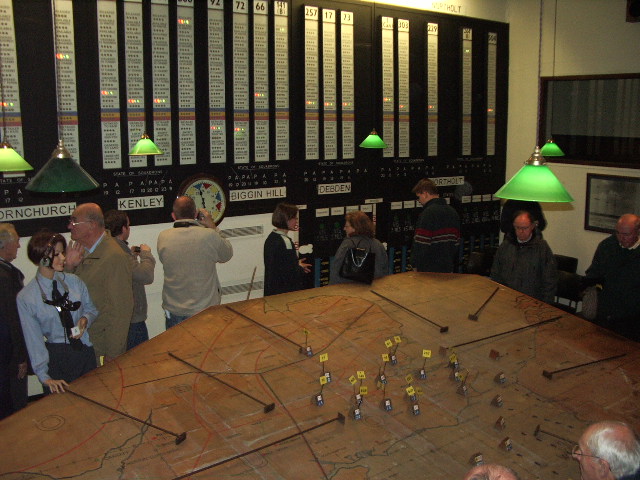
Restored Battle of Britain operations room in an underground bunker at former RAF station Uxbridge.
Photo by Ian Mansfield via Wikimedia Commons.
Technology played its part, mostly behind the scenes – yes, we mean the backroom boffins – in equipping Britain to hold firm and defeat the Germans. As today’s commemorations focus on the pilots and ground crew who saw off the Luftwaffe, spare a thought for the technologists whose efforts also saved the western world.
Radar and radio
Chief among the technological innovations that gave the RAF the edge was radar. In the 1930s Britain was one of the world leaders in radar (thanks in part to a bizarre and unsuccessful experiment to kill sheep with a death ray) leading to the building of radar stations all around the British coast.
Sir Robert Watson-Watt, today regarded as the father of radar, was instrumental in devising a method of bouncing radio waves off a flying aeroplane to figure out its location. He turned that 1935 concept into the fully operational Chain Home and Chain Home Low air defence networks inside four years.
Without radar, the RAF was totally reliant on humans with binoculars spotting incoming formations of German bombers; radar gave the air force an early warning capability as hostile aircraft formed up over France before crossing the Channel.
Before radar came radio direction-finding. The RAF’s Home Defence Units were first established in the 1920s and mastered the art of pinpointing an aeroplane’s location from radio transmissions made by its pilots. Though less high profile than radar, the HDUs’ activities allowed the RAF to “see” beyond the range of radar as Luftwaffe bomber formations, transmitting to each other over France, formed up ready for a raid over British soil.
Signals intelligence and compsci
Not far behind radar was the crucial role of what was then the Government Communications and Cipher School (GC&CS), based at Bletchley Park. Today the site is home to the National Museum of Computing but in the dark days of the 1940s it was where codebreakers deciphered German military communications.
Breaking Nazi Germany’s encryption was a vast task, and in the days before computers extremely labour intensive; between 9,000 and 12,000 personnel worked at Bletchley during the Second World War. The demands of RAF and other military commanders for speedy decryption of enemy messages directly contributed to the development of early computer science; Alan Turing worked at Bletchley Park, helping devise improvements to electromechanical crypto-breaking machines that resulted in the Bombe, a very early computer.
March 20, 2020
“Aces In Exile” Pt.1 – Non-British RAF Pilots – Sabaton History 059 [Official]
Sabaton History
Published 19 Mar 2020“Aces In Exile” prevail! Did you know that the war in the skies above Britain was not just fought by men from the British Isles alone? It was also fought by men who were forced to flee their home-countries from Nazi occupation and journey through war-torn Europe to continue the resistance. As France fell, pilots from Poland, Czechoslovakia and Canada found themselves once more in the seat of foreign fighter-planes, to fend off the German war-machine in the Battle of Britain.
Support Sabaton History on Patreon: https://www.patreon.com/sabatonhistory
Listen to “Aces in Exile” on the album Coat of Arms here:
CD: http://bit.ly/CoatOfArmsStore
Spotify: http://bit.ly/CoatOfArmsSpotify
Apple Music: http://bit.ly/CoatOfArmsAppleMusic
iTunes: http://bit.ly/CoatOfArmsiTunes
Amazon: http://bit.ly/CoatOfArmsAmzn
Google Play: http://bit.ly/CoatOfArmsGooglePlayCheck out the trailer for Sabaton’s new album The Great War right here: https://www.youtube.com/watch?v=HCZP1…
Listen to Sabaton on Spotify: http://smarturl.it/SabatonSpotify
Official Sabaton Merchandise Shop: http://bit.ly/SabatonOfficialShopHosted by: Indy Neidell
Written by: Markus Linke and Indy Neidell
Directed by: Astrid Deinhard and Wieke Kapteijns
Produced by: Pär Sundström, Astrid Deinhard and Spartacus Olsson
Creative Producer: Joram Appel
Executive Producers: Pär Sundström, Joakim Broden, Tomas Sunmo, Indy Neidell, Astrid Deinhard, and Spartacus Olsson
Post-Production Director: Wieke Kapteijns
Edited by: Iryna Dulka
Sound Editing by: Marek Kaminski
Maps by: Eastory – https://www.youtube.com/c/eastoryArchive by: Reuters/Screenocean https://www.screenocean.com
Music by Sabaton.Sources:
– IWM: CH1733, Q 69697, CH1501, CH 1438, CH 1291, CH 1294, CH 12321, CH 1286, CH 1540, CH 587, CH 1538, CH 1535, CH 1137, CH 2440, HU 106457, D 1731, CH 4790
– Photo of the Battle of Britain Monument by Eluveitie from Wikimedia
– Instytut Pamięci NarodowejAn OnLion Entertainment GmbH and Raging Beaver Publishing AB co-Production.
© Raging Beaver Publishing AB, 2019 – all rights reserved.
December 15, 2019
The Empire Strikes Back – Britain’s Operation Compass – WW2 – 068 – December 14, 1940
World War Two
Published 14 Dec 2019The First British offensive of the War begins in North Africa. Meanwhile, the German Knickebein system is designed for bombers to accurately bomb British targets at night. This is what the Brits do to stop them.
Join us on Patreon: https://www.patreon.com/TimeGhostHistory
Or join The TimeGhost Army directly at: https://timeghost.tvFollow WW2 day by day on Instagram @World_war_two_realtime https://www.instagram.com/world_war_t…
Join our Discord Server: https://discord.gg/D6D2aYN.
Between 2 Wars: https://www.youtube.com/playlist?list…
Source list: http://bit.ly/WW2sourcesWritten and Hosted by: Indy Neidell
Produced and Directed by: Spartacus Olsson and Astrid Deinhard
Executive Producers: Bodo Rittenauer, Astrid Deinhard, Indy Neidell, Spartacus Olsson
Creative Producer: Joram Appel
Post-Production Director: Wieke Kapteijns
Research by: Indy Neidell
Edited by: Iryna Dulka
Map animations: Eastory (https://www.youtube.com/c/eastory)Thumbnail Colorization (Archie Wavell) by:
– Julius Jääskeläinen – https://www.facebook.com/JJcolorization/Colorizations by:
– Dememorabilia – https://www.instagram.com/dememorabilia/
– Adrien Fillon – https://www.instagram.com/adrien.colo…Sources:
– IWM: F 4539, B 10600, CM 355, E 6600, E 3720E, E 1416, E 1378, E 4792
– Tropenmuseum, part of the National Museum of World Cultures– Prison icon by FORMGUT. from the Noun Project; Compass by RULI from the Noun Project.
Archive by Screenocean/Reuters https://www.screenocean.com.
A TimeGhost chronological documentary produced by OnLion Entertainment GmbH.

